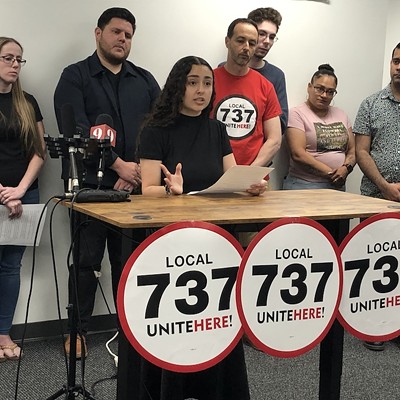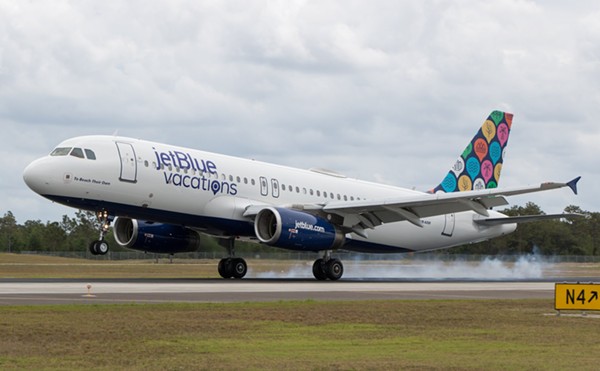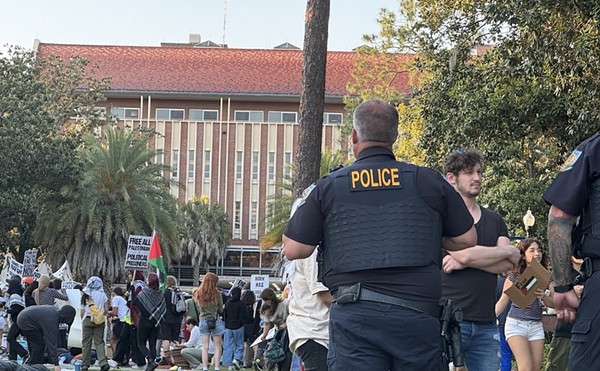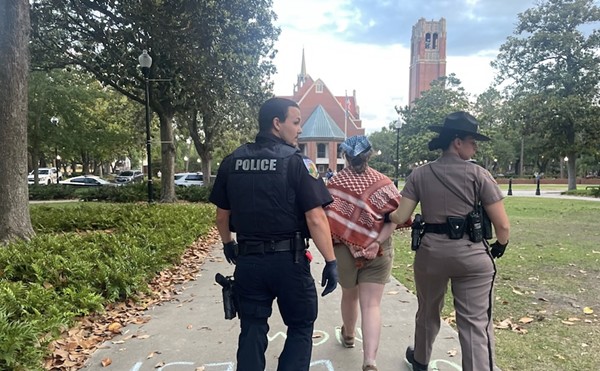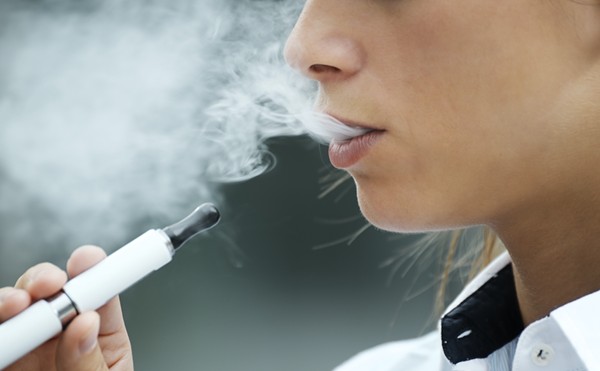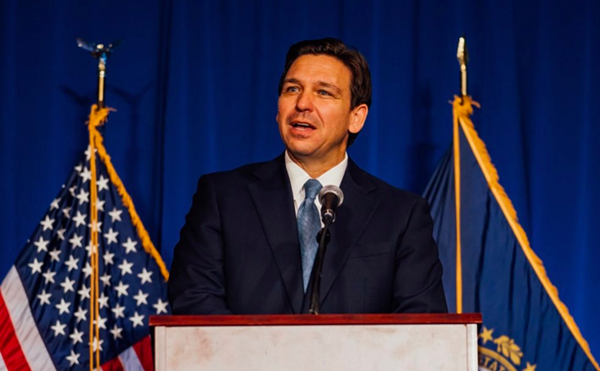Randy Freeman stands up formally to ask his question, with challenge in his voice. "Who called it the ‘Ocoee Massacre,'" he demands.
Twenty-five feet away, on a small riser in the corner of the coffee shop at Border's Books on the outskirts of Ocoee, Cathleen Armstead stammers as she explains that Zora Neale Hurston, Central Florida's most famous black writer, called it a "riot," but that the National Association for the Advancement of Colored People "referred to it as a massacre." She admits she is unsure who first coined the term.
"So we're using terms that we have no origin for," Freeman states indignantly.
Armstead, a sociologist at Valencia Community College, does not budge. "The word ‘massacre' has a distinct meaning in sociology," she says. "An incident becomes a massacre when more than six people are killed."
In 1920 -- three years before a rampage burned the name of Rosewood into history -- something between eight and 60 people were killed, and nearly 500 black people fled Ocoee amid fires that burned 26 black homes, two churches and a lodge. The question of the number killed, and of who was responsible, dominated last weekend's "Democracy Forum" as it has haunted the town's conscience for eight decades. The Ocoee massacre is the pivot point on which race relations in West Orange County hinge. It is the rumor that kept black people out of town, and the boast that puffed the chests of racist whites. It is a shape-shifting tale of brutality and shame, changing to match the received wisdom about race in different eras, in households black and white.
It also comes as a surprise to many newcomers. Although mentioned ocassionally in newspaper articles, and the subject of a front-page retrospective by the Sentinel in 1986, the incident has not found a defined place in local lore. Curtis Michelson, a founder of Democracy Forum, says he learned of the massacre only two years ago. The news shook him, he says, because he had recently steered a black friend to an Ocoee radio station for training, and the friend had quit the internship without saying why.
"I wanted to know for myself what happened out there, and why people are still scared today," Michelson says. So last year he gathered some volunteers and secured a small grant from the Burt and Mary Meyer Foundation to research the incident that some prominent residents of this bedroom boomtown would rather see forgotten -- or at least not frozen in place and time by indisputable fact.
Last week Mayor S. Scott Vandergrift visited Carolyn Towlin, the Border's manager, on what she took as a mission to dissuade her from hosting the forum on the grounds that white peoples' views would not be fairly represented.
"No one spoke to me about it," Vandergrift huffs as the presentation begins. "I've lived here all my life. I've heard 10 versions of the story. The important thing now is we've come a long way. We're an international city. In my neighborhood alone there are Jamaicans, Puerto Ricans. ...
"The people putting on this forum," he concludes, "are looking to exploit something."
Forum organizers say they want the town to face its history. They want a monument to the event placed somewhere prominent, and a place in the school's curriculum for study of the massacre. They'd also like a marker for the grave in Orlando's Greenwood Cemetery where July Perry, the incident's central figure, is buried. "I think we owe him that much," says Francine Boykin, an Apopka resident and member of the Forum.
But there's another element to the research as well. Victims of the Rosewood incident of 1923, where four died and scores were burned from their homes, took their claims to the state for reparations. The state reluctantly set aside $2.1 million.
When some suggested a similar effort should be made on behalf of Ocoee's victims in 1994, lawyers for Rosewood's victims rejected it, in part because the Ocoee massacre happened in the course of a single day, giving state authorities no time to react, and because Ocoee's black land owners (or their survivors) were paid for their land soon after they abandoned it, by a committee of Ocoee's prominent whites.
Whatever happened in Ocoee on Nov. 2, 1920, it was just as political. In cities across America the Ku Klux Klan had staged rallies to suppress black voting, which would favor Republicans. Locally, Judge John M. Cheney, with the help of Ocoee's two most prominent black men, July Perry and Mose Norman, registered black voters. Cheney meant to become the first Republican senator from Florida. The Klan took notice.
When Norman tried to vote, he was refused for not paying his poll tax. He may have been struck and sent away, but after conferring with Cheney, he returned to the polls, allegedly to get the names of the people who were illegally trying to keep him from voting. A shotgun was discovered in his car, and he was pistol-whipped and sent packing again.
As night fell, some people gathered and discussed the day's events at the general store. They may have been told that Perry was harboring the insolent Norman. They may have heard that Perry had raised a small army of blacks who meant to attack the whites. The whites formed a posse and surrounded Perry's house.
"He came down with a sawed-off shotgun to vote!" says Betty Hager.
"It wasn't sawed off," responds someone on the riser.
"Were you there?"
Hager was the town's first city commissioner in the 1960s. Her father was the lead man at Perry's house that night 78 years ago. Today she is sitting near the back of the cafe, next to the mayor, as part of a contingent of citizens who have come to correct the record. To let it be known that the good people of Ocoee were blind-sided on that long-ago day by outside agitators. To tell the story -- heretofore unknown -- of heroic Ocoeans who defended their black neighbors.
"Our home white people were trying to protect their own black workers," says Nancy Maguire, curator of the Withers-Maguire House, Ocoee's historic museum.
"My great grandfather had a barn," says J. Thomas Shuman. "Someone pointed it out and said he had black people in it [hidden from the mob]. I go to a church. It's one-third black, one- third Hispanic and one-third white. If this [forum] is a thing to take an old wound and jab it open ..."
Shuman whirls and grabs the right hand of the black man sitting behind him, Fitzhugh Long. "I can take this man's hand," Shuman says, voice rising. "I don't know much about him, but I see he is a good man. He's never done anything to me. He's welcome in my house ..."
"There's no historical proof that a massacre occurred," insists Freeman. "Obviously a travesty occurred. People from Tampa came in, and from other places -- Sanford -- they were KKK members, wearing hoods. Tom Shuman's grandfather -- my grandfather -- stood in front of barns with shotguns to protect black citizens!
"We don't deserve to be known for this any more than Gettysburg should be blamed for the Civil War."
Someone asks where the Democracy Forum's members live: "You have no right to come in here and start renaming something."
Zora Neale Hurston wrote an account of the incident for the Works Progress Administration in 1939, which was republished by Essence magazine in February 1989. "Witnesses both white and negro say it was not the regular population of Ocoee which participated in the affair," Hurston says in her introduction. She spins a tale of heroism, "with the mobs seeking blood and ashes, and July Perry standing his lone watch over his rights to life and property."
Stetson Kennedy, who helped edit Hurston's writing for the WPA, told the Sentinel in 1989 that Hurston wrote her story to dispute an earlier account which said 35 people died. Hurston, who by the 1930s had established a name for herself in New York but traveled regularly back to her home in Eatonville, said 35 was too high. She did not give a death toll, however, in her own account.
Hurston also never mentioned the Ku Klux Klan, and Kennedy said her absolution of Ocoee's population was standard for racially sensitive stories of the time.
The undisputed facts, however, illustrate a massacre. When the posse surrounded Perry's house, shots were fired. Two white men, Elmer McDaniel and Leo Borgard, were shot to death; six others were wounded as they tried to break in.
Reinforcements were called. More than 200 whites arrived to "patrol." They burned the town's two black settlements. Blacks fled into the groves. Perry was shot, taken to the Orlando jail, possibly dragged behind a car, hanged and shot once more. Norman was never seen again.
Within a few days every black person but one had evacuated Ocoee. Twenty-one of these blacks had owned land [see sidebar], some of it -- Perry's sugar cane fields and Norman's citrus groves -- substantial. Whites bought the blacks out. It is unlikely they overpaid.
In 1969 Lester Dabbs, then preparing to open a desegregated junior high in Apopka, wrote an account of the incident as his master's thesis at Stetson University. Frustrated by lack of official records (the sheriff of the time told him he had been a deputy in 1920 "and, in his memory, no such event had taken place"), Dabbs interviewed 12 survivors and their descendants, including two blacks. Their recollections form the backbone of his 47-page thesis.
Dabbs went on to become an Ocoee city commissioner and then the mayor, but seldom speaks of his findings. He told the Sentinel in 1989 that the events should be left in the past. He has not spoken to the Democracy Forum researchers.
Vandergrift, who was mayor in the early 1970s and defeated Dabbs for the post again in 1992, says the thesis is poor.
But Dabbs' thesis is one of the most detailed accounts of the massacre, and it lays bare the racial attitudes in Ocoee in 1969 as the town struggled to integrate its school.
"At present, Ocoee Junior-Senior High School is the only secondary school in the county without at least token integration," Dabbs wrote. "Many adults and students in the community are proud of the fact that the local Klan unit was the third one formed in the state." Proud folks were in the minority, Dabbs wrote, but they were vocal.
A key Dabbs source was Hager's father, Col. Sam C. Salisbury, whom he identified as "a former West Point Cadet, Standard Oil Co. ship's captain, Ocoee City Official and participant in the events." Salisbury was also a World War II hero who had served for a year as Orlando's police chief, Hager says, probably during the late teens. He told Dabbs that at the time of the massacre, "90 percent of all law enforcement officers, judges, public servants and lawyers" in Winter Garden and Ocoee were Klan members. And Salisbury told Dabbs a story seemingly meant in part to justify the later massacre:
Two months prior to the riot, a dance in Clarcona drew most of Ocoee's white men and their wives, Dabbs recounted. "During their absence a gang of roving negroes went from white residence to white residence, apparently with the intention of intimidating the remaining white people. This group of negroes stopped in front of Mr. J.R. Pounds' residence and Mr. Pounds' son-in-law, Sam Salisbury, got his pistol and confronted the negroes at the side door of the house. After considerable discussion about whether they (the negroes) should take any action at the Pounds' residence, they decided that no action would result because Mr. Pounds was well-liked by many of the negroes in the area. No violence transpired anywhere on this night in question, though similar confrontations took place all over town."
Salisbury told Dabbs that Ocoee's blacks were warned after that to cease their "inflammatory" conduct, and that they did.
Dabbs' paper did not evaluate Salisbury's veracity, but relied on him and other Ocoee Klan members for much of his information. His account differs from Hurston's in that Dabbs says Ocoee whites planned from the start to keep blacks from voting, and Dabbs names the key players, including the notary public, Justice of the Peace R.C. Biglowe, who went fishing in order to make it difficult for black voters to find him and claim their rights.
The story of the shotgun is unclear; it is clear only that Norman tried to vote that day, and failed.
Dabbs' paper says after the polls closed, an ex slave named Burly Jones told a group of whites downtown at the store that a group of blacks were at July Perry's house cooking up trouble. Salisbury said he led a group of 10 armed white men to Perry's door while others broke off to head to Mose Norman's.
"Upon answering the knock on his door, lantern in hand, and seeing the white men assembled in his yard (actually the house was surrounded), July said, ‘Yas suh, boss, let me git my coat.' As he turned to reenter the house, Mr. Salisbury grabbed him and in the forthcoming struggle pounded him on the head with the butt of an Enfield rifle as he held him by a neck hold with the other arm. Suddenly a rifle barrel appeared from out of the house and was placed in the abdomen of Mr. Salisbury. Instinctively, the gun was brushed aside and at that moment the negro woman holding the rifle fired, the bullet striking Mr. Salisbury in the right forearm."
The story goes on, with guns fired by "approximately 37 armed negroes in the house, most of whom escaped through a trap door in the floor and fled into a cane field" -- but not before killing two men and injuring six more.
Perry's nephew, Richard Allen Franks, described for Dabbs a more likely version of Perry's army. Franks said Perry was in the house with only his wife and daughter, his sons and two hired hands in outbuildings in back.
Since that report, the Democracy Forum volunteers have uncovered material Dabbs didn't, including FBI files and the report and notes of the NAACP investigation, which put the death toll between 30 and 60. Census data from 1910 and 1920 were made available only a few years ago, and they name 495 black citizens in 1920, two in 1930, then none until 1980. "On the level of loss of life and property, Ocoee had more significance than Rosewood," says Boykin. "It was political and economic."
No blacks voted anywhere in Orange County for 17 years after the incident.
Hager suggests calling it the West Orange riot (or massacre), since Ocoee had not been incorporated at the time. Forum members consider this as the talk breaks up.
The search for descendants of the survivors has just begun, says Michelson; several of the white contingent sign up to help.
"What this has caused is a major dialogue," says Freeman. "What people all want to do is arrive at the truth."
"The truth, then, won't necessarily make what we have now any different," says Inez Long.
But it will. The story of the Ocoee massacre -- or the version one was told as a child -- defines the Ocoean's identity and marks the character of his kin in a place that hired its first black city worker in 1986 and that even in the 1960s posted a notice at the town line that said "Dogs and Negroes Not Welcome."
The scars of that decade's integration efforts, too, are fresh in the psyches of people at the forum. And the question of the Klan -- once the region's premier social organization and the foundation on which so much of today's prominence, wealth, and power rests -- cannot easily be brushed away.
"The Klan, at that time, it was necessary," says Hager. "The whites were just as afraid of the blacks as the blacks were of the whites. With the blacks coming over and maurading, it just makes common sense. But," she says, "there hasn't been any Klan activity in years."
As Ocoee has grown and changed, city leaders have worked hard to soften its image, and Hager has been at the forefront of that effort. In 1994 she was drafted to organize its first Founder's Day celebration. This year's festivities kick off at 10 a.m. on Oct. 17. There will be a jazz band, dancing and performances, plus a bake-off and a classic car show. Hager is a little disappointed that the classic cars forced the cancellation of the parade.
As usual, Sons of the Confederate Veterans will camp out overnight at the Withers-Maguire House and present "historical demonstrations." The evening will be capped by the fire-delayed, Fourth-of-July fireworks. Naturally, the event is open to everyone.
"Some of my best friends are black," Hager says. "I invited some to my birthday party.
"They didn't come, but I guess they had other things to do."
Search party;;
1920 Census of Ocoee lists the following blacks who owned their homes and land. Democracy Forum currently is looking for descendants of these people in its ongoing research into the 1920 massacre. Contact Francine Boykin at (407) 886-9323 with information.
Anderson, Garfield and Janey Bell; two children; eldest son Sidney
Battsey, Randolph and Annie; daughters Alice and Bessie; owned farm
Blackshear, Martin and Candyce; four children, oldest son Morgan
Blue, Sanborri and Lilly
Dennys, Thomas and Lavinia
Dighs, Edward and Willamina
Edwards, John and Genie; oldest son Usteen
Frank (or Franks), Daniel and Carrie; four children, oldest son Allen
Green, Sally; six children, oldest son, Jeremiah; owned farm
Hampton, Jackson and Anna; owned farm
Hightower, Valentine and Janie; three children; owned farm
Johnson, Stephen and Julia; three grandsons, oldest James
Langmede, James and Eva; son Starland
Lynch, Richard and Fanny
McRae, William and Doda
Penzer, Kerry and Elisa; three children, oldest son Edson
Moore, Rocky and Daisy; five children, oldest son William
Nelson, Stephen and Julia; two children, son Edward
Perry, Julius P. and Stella; five children, oldest son Charles; home listed as "contested"
Surrency, Jessie and Grace; four children, oldest son Damott
Slater, Victoria; son Mason
Warron, Wade and Rhina; five children, oldest son Porter


